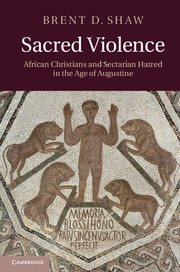Book contents
- Frontmatter
- Contents
- Abbreviations
- Maps
- Acknowledgments
- Introduction
- Chapter 1 This terrible custom
- Chapter 2 Church of the traitors
- Chapter 3 A poisonous brood of vipers
- Chapter 4 Archives of memory
- Chapter 5 The city of denial
- Chapter 6 Ravens feeding on death
- Chapter 7 Little foxes, evil women
- Chapter 8 Guardians of the people
- Chapter 9 In the house of discipline
- Chapter 10 Sing a new song
- Chapter 11 Kings of this world
- Chapter 12 We choose to stand
- Chapter 13 Athletes of death
- Chapter 14 Bad boys
- Chapter 15 Men of blood
- Chapter 16 Divine winds
- Chapter 17 So what?
- Appendix A Bishops and bishoprics in Africa: the numbers
- Appendix B Origins of the division: chronology
- Appendix C The Catholic conference of 348
- Appendix D The Edict of Unity and the Persecution of 347
- Appendix E The mission of Paul and Macarius
- Appendix F Historical fictions: interpreting the circumcellions
- Appendix G The archaeology of suicide
- Appendix H African sermons
- Bibliography
- Index
- References
Chapter 6 - Ravens feeding on death
Published online by Cambridge University Press: 07 September 2011
- Frontmatter
- Contents
- Abbreviations
- Maps
- Acknowledgments
- Introduction
- Chapter 1 This terrible custom
- Chapter 2 Church of the traitors
- Chapter 3 A poisonous brood of vipers
- Chapter 4 Archives of memory
- Chapter 5 The city of denial
- Chapter 6 Ravens feeding on death
- Chapter 7 Little foxes, evil women
- Chapter 8 Guardians of the people
- Chapter 9 In the house of discipline
- Chapter 10 Sing a new song
- Chapter 11 Kings of this world
- Chapter 12 We choose to stand
- Chapter 13 Athletes of death
- Chapter 14 Bad boys
- Chapter 15 Men of blood
- Chapter 16 Divine winds
- Chapter 17 So what?
- Appendix A Bishops and bishoprics in Africa: the numbers
- Appendix B Origins of the division: chronology
- Appendix C The Catholic conference of 348
- Appendix D The Edict of Unity and the Persecution of 347
- Appendix E The mission of Paul and Macarius
- Appendix F Historical fictions: interpreting the circumcellions
- Appendix G The archaeology of suicide
- Appendix H African sermons
- Bibliography
- Index
- References
Summary
That Jews held a central place in the religious conflicts between Christian communities in Africa in the age of Augustine might seem surprising. That there were significant numbers of Jews in a few large communities in Africa during this period is almost certain, but the plain fact is that relatively little is known about them. And much that has been claimed to be known vanishes under close scrutiny. What remains amounts to a few scattered literary references, some archaeological artifacts, and a little nomenclature. And what we can know from these sources is bedeviled by an even bigger problem – a dark figure lurking in the background. That is to say, there were many, if not very many, Jews whom we cannot identify at all simply because, in everything from names to dress, they looked just like everyone else. This singular fact produces a vexatious problem for the historian: just what did Jewish communities in the Maghrib of the Roman period look like when so many of the individuals that constituted them are invisible to our gaze?
Although Jewish communities did exist and could have been the object of Christian violence, most of the hostile “against-the-Jews” polemic that is found in Christian writings does not seem to have served to mobilize gang actions or mob violence against them. There is very little evidence to indicate that Christians in Africa of the period actively engaged in violent attacks on Jews as such or even against Jews in combination with others. Indeed, the most insidious effects (of which we know) of the pictures and language of hate developed in Africa actually took place outside of it in Christian rioting against Jews that took place at Mago (Minorca) in the Balearics in 418. On the bare evidence (as pitiful as it is) this seems to have been the pattern: the words generated for one purpose in Africa assumed a more malign and savage power when exported to new lands where their production was decontexualized and their hate-effect was purified. The urban riots in cities like Carthage, Sufes, and Madauros, and the episodes of rural violence in the towns and villages around Hippo Regius, conversely, are never known to have involved Jews as their principal targets. The silence could be the result of a peculiar blindness in the surviving literary sources, but this seems unlikely given that most of them are the products of Christian writers who had an historical and a theological fascination with Jews. Any significant violent encounters between Jews and Christians, had they existed, would surely have been reported or at least alluded to in their writings.
- Type
- Chapter
- Information
- Sacred ViolenceAfrican Christians and Sectarian Hatred in the Age of Augustine, pp. 260 - 306Publisher: Cambridge University PressPrint publication year: 2011

